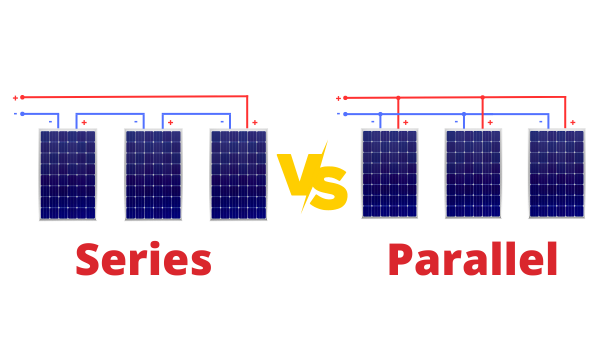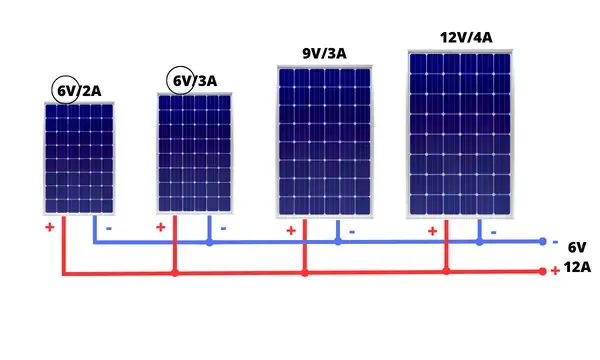Wiring Solar Panels in Series vs Parallel - The Best Solution

In this article, we explain the difference between wiring solar panels in series vs parallel.
Today, solar panels are available in the range of 3 watts to 700 watts. But often we need power in the kW range. Therefore, we will need to connect N numbers of solar panels to achieve such power.
There are two options for connecting multiple solar panels together: series and parallel. The question is, which option is best for your situation?
Whether the solar panels are connected in series or parallel, the total wattage of the system increases in the same way at each of these connections. Your primary concern is whether or not your solar panels generate enough power to meet your energy needs. So you might be wondering "Does it really matter how wired your solar panels are in series vs parallel?".
Yes, of course, the way the solar panels are connected is critical to improving system efficiency and maximizing cost savings and revenue.
The Main Difference in Wiring Solar Panels in Series vs Parallel
In short, the main difference between connecting a solar panel system in series and parallel is the output voltage and current of the system.
When solar panels are connected in series, the output voltages from each panel are summed together, while the output current remains the same. When solar panels are connected in parallel, the resulting currents leaving each panel are summed together, while the total system voltage remains the same.
Wiring Solar Panels in Series
When you connect solar panels in series, you connect the positive terminal of one panel to the negative terminal of the next panel, and so on. This results in the voltage of the system increasing while the current remains the same as that of a single panel.
The total voltage of the system will be equal to the sum of the individual voltages of the panels. For example, if you connect 3 solar panels with 12 volts and 5 amps, the total voltage of the system will be 36 volts (12V + 12V + 12V). However, the total current of the system will still be 5 amps.Check out our article to learn about How to build a circuit to charge a 12v battery with a solar panel.
Why Series?
A low-amperage solution: One of the benefits of connecting solar panels in series is that it can allow you to use smaller gauge wiring. This can save you money and effort during the installation process, particularly if you are installing the solar panels in a location where long cable runs are required.
Importance for each individual panel in a series connection: The performance of the entire string of series-connected solar panels can be affected by the performance of the lowest-performing panel. When one panel in the string is shaded or underperforming for any reason, it reduces the current output of the entire string.
Meeting the operating voltage window requirements of the inverter: It is important to keep in mind that inverters have a specific voltage range at which they operate efficiently. By connecting solar panels in series, the voltage of the array increases, which can help ensure that the system operates within the required voltage range of the inverter.
Wiring Solar Panels in Parallel
When connecting solar panels in parallel, the positive terminals of all the panels are connected together, and the negative terminals are also connected together. This creates a parallel circuit where the voltage across each panel is the same but the current output is additive. So, the current output of the parallel circuit is equal to the sum of the current outputs of each panel.
Why Parallel?
Parallel connections are more commonly used in smaller and simpler solar systems, such as those used for camping, RVs, or boats, which operate at a lower voltage. For example, in a 12V system, connecting solar panels in parallel can help keep the charging capabilities at 12V while increasing the current output.
PWM charge controllers are commonly used in parallel connections because they work well for smaller systems that don't require a high level of efficiency.
Connecting panels in parallel requires using very thick wires to handle the higher current (15 amps vs 5 amps in the examples above). In addition, paralleling systems also require additional equipment, such as branch connectors or combine boxes, to combine the output of multiple solar panels and route the combined output to a charge controller. This adds additional cost and complexity to the system.
Connecting solar panels in parallel allows more power to be obtained without exceeding the maximum input voltage rating of the inverter or charge controller.
When solar panels are connected in parallel, each panel operates independently of the others, which means that shading on one panel will not affect the output of the other panels in the array. This is because the electrical current produced by each panel flows directly to the inverter or PWM charge controller.Series – Parallel Connection
In this configuration, two or more panels are connected in series to increase the voltage, forming two equal strings. These strings are then connected in parallel to increase the amperage of the system.
String : N-number of solar panels connected in series.
Array : N-number of solar panels connected in series and parallel combinations.
In a solar panel array that is configured with two strings of panels, the total voltage of the array will be equal to the voltage of a single string. Similarly, the total current of the array will be equal to the sum of the currents of both strings. For example, if each string produces 5 amps of current at 36 volts, the total voltage of the array will also be 36 volts, while the amperage of the array will be 10 amps.
Why Series-Parallel?
This type of wiring is commonly used in larger solar panel arrays to balance the voltage and current (wattage) requirements of the system.
Solar Panels in Series or Parallel with MPPT
An MPPT charge controller adjusts the voltage and current output of the solar panels so that they match the voltage and current requirements of the battery bank.
A pulse width modulation (PWM) charge controller reduces the voltage output of the solar panels to match the voltage of the battery bank. However, this can result in significant power loss, especially when the solar panels are connected in a series configuration.
This is because when solar panels are connected in series, the voltage output of the string is additive, while the current output remains the same. A PWM charge controller reduces the voltage output of the string, but it doesn't adjust the current output, which can result in a significant loss of power.
In contrast, an MPPT charge controller can adjust both the voltage and current output of the solar panels to ensure that the system operates at its maximum efficiency.
While a PWM charge controller may be a cheaper option, it's not recommended for solar panel strings connected in series. An MPPT charge controller is a more efficient option that can help to maximize the power output of the solar installation.
Wiring Solar Panels in Series vs Parallel - Which is Better
The best wiring configuration for your solar panel system is the connection that will provide you with the optimal power for your requirements.
Connecting solar panels in series can be a good option when a low-amp system is desired and when the panels are expected to receive constant sunlight throughout the day.
On the other hand, connecting solar panels in parallel can be a better option when a low-voltage system is desired and when the panels are expected to experience mixed-light conditions.
A series-connected solar panel system may be more productive in the early morning, late afternoon, and during overcast weather. This is because the voltage output of the series-connected panels remains relatively constant, even as the current output fluctuates due to changes in light conditions.
In contrast, a parallel-connected solar panel system may see more significant output fluctuations in response to changes in light conditions.
For example, most solar panels in the 100-watt range typically have an output voltage between 17-20 volts. To charge a 12V battery bank, 3 solar panels must operate at 77% capacity or more if they are wired in parallel. If solar panels are wired in series. These three panels only need to operate at around 25% capacity.
If shading is a concern, a parallel connection may be more appropriate.
Series or Parallel For Mixing Different Wattage Solar Panels:
So far, in all previous examples, we have been wiring solar panels in series vs parallel using panels of the same size and with identical electrical ratings. But what if I have different-sized panels from different manufacturers with different electrical ratings? Would it be better to connect solar panels in series or parallel?
For a highly efficient solar system, the use of identical panels is the ideal solution and the best option, but it is not a requirement for small off-grid systems. It is possible to mix different solar panels if they have different electrical ratings, but doing so requires adhering to some important guidelines:
- If you want to wire solar panels in series, all of the panels should have the same or similar current ratings. This is because in a series connection, the current output of the entire series string will be determined by the panel with the lowest current rating.
- On the other hand, when wiring solar panels in parallel, it is important to ensure that the voltage of each panel is the same or similar. If the voltage of each panel is not the same, the voltage output of the panels will be set to the lowest-rated panel's voltage value.
Solar Panels in Series with Different Voltages and Currents

If we connect 4 solar panels (6V/2A), (6V/3A), (9V/3A), (12V/4A), the array will have a total power output of (33V x 2A) = 66 watts.
If the first and fourth panels have a current output of 3 amps, the total power output will be (33V x 3A) = 99 watts. This means that the total energy will decrease by about 33%.
Solar Panels in Parallel with Different Voltages and Currents

In a parallel connection, the array will have a total power output of (6V x 12A) = 72 watts.
Series vs Parallel Connection: Pros & Cons
Connecting solar panels in series is a common practice in solar panel installations, as it can result in higher voltages and lower currents, which can reduce the cost of cabling and make the system more efficient. However, it is important to ensure that the maximum voltage of the charge controller is not exceeded when connecting panels in series.| Wiring Solar Panels | Pros | Cons |
|---|---|---|
| Series |
|
|
| Parallel |
|
|






Your series diagram is wrong 3V 54A ?